Synthesis and Characterization of Ethylenedithio-MPTTF-PTM Radical Dyad as a Potential Neutral Radical Conductor
Abstract
:1. Introduction
2. Results and Discussion
2.1. Synthesis
2.2. Characterization
2.2.1. Electrochemical Properties
2.2.2. Optical Properties
2.2.3. Magnetic Properties
3. Materials and Methods
3.1. General Methods for Synthesis and Characterization
3.2. Synthesis and Characterization
4. Conclusions
Supplementary Materials
Acknowledgments
Author Contributions
Conflicts of Interest
References
- Haddon, R.C. Design of organic metals and superconductors. Nature 1975, 256, 394–396. [Google Scholar] [CrossRef]
- Cordes, A.W.; Haddon, R.C.; Oakley, R.T. Molecular conductors from neutral heterocyclic π-radicals. Adv. Mater. 1994, 6, 798–802. [Google Scholar] [CrossRef]
- Kobayashi, A.; Fujiwara, E.; Kobayashi, H. Single-Component Molecular Metals with Extended-TTF Dithiolate Ligands. Chem. Rev. 2004, 104, 5243–5264. [Google Scholar] [PubMed]
- Pal, S.K.; Itkis, M.E.; Tham, F.S.; Reed, R.W.; Oakley, R.T.; Haddon, R.C. Resonating valence-bond ground state in a phenalenyl-based neutral radical conductor. Science 2005, 309, 281–284. [Google Scholar] [CrossRef] [PubMed]
- Mandal, S.K.; Samanta, S.; Itkis, M.E.; Jensen, D.W.; Reed, R.W.; Oakley, R.T.; Tham, F.S.; Donnadieu, B.; Haddon, R.C. Resonating valence bond ground state in oxygen-functionalized phenalenyl-based neutral radical molecular conductors. J. Am. Chem. Soc. 2006, 128, 1982–1994. [Google Scholar] [CrossRef] [PubMed]
- Pal, S.K.; Itkis, M.E.; Tham, F.S.; Reed, R.W.; Oakley, R.T.; Haddon, R.C. Trisphenalenyl-based neutral radical molecular conductor. J. Am. Chem. Soc. 2008, 130, 3942–3951. [Google Scholar] [CrossRef] [PubMed]
- Tenn, N.; Bellec, N.; Jeannin, O.; Piekara-sady, L.; Auban-senzier, P. A Single-Component Molecular Metal Based on a Thiazole Dithiolate Gold Complex. J. Am. Chem. Soc. 2009, 131, 16961–16967. [Google Scholar] [CrossRef] [PubMed]
- Yu, X.; Mailman, A.; Lekin, K.; Assoud, A.; Robertson, C.M.; Noll, B.C.; Campana, C.F.; Howard, J.A.K.; Dube, P.A.; Oakley, R.T. Semiquinone-bridged bisdithiazolyl radicals as neutral radical conductors. J. Am. Chem. Soc. 2012, 134, 2264–2275. [Google Scholar] [CrossRef] [PubMed]
- Leitch, A.A.; Lekin, K.; Winter, S.M.; Downie, L.E.; Tsuruda, H.; Tse, J.S.; Mito, M.; Desgreniers, S.; Dube, P.A.; Zhang, S.; et al. From magnets to metals: The response of tetragonal bisdiselenazolyl radicals to pressure. J. Am. Chem. Soc. 2011, 133, 6050–6060. [Google Scholar] [CrossRef] [PubMed]
- Isono, T.; Kamo, H.; Ueda, A.; Takahashi, K.; Nakao, A.; Kumai, R.; Nakao, H.; Kobayashi, K.; Murakami, Y.; Mori, H. Hydrogen bond-promoted metallic state in a purely organic single-component conductor under pressure. Nat. Commun. 2013, 4, 1344–1346. [Google Scholar] [CrossRef] [PubMed]
- Ueda, A.; Yamada, S.; Isono, T.; Kamo, H.; Nakao, A.; Kumai, R.; Nakao, H.; Murakami, Y.; Yamamoto, K.; Nishio, Y.; et al. Hydrogen-Bond-Dynamics-Based Switching of Conductivity and Magnetism: A Phase Transition Caused by Deuterium and Electron Transfer in a Hydrogen-Bonded Purely Organic Conductor Crystal. J. Am. Chem. Soc. 2014, 136, 12184–12192. [Google Scholar] [CrossRef] [PubMed]
- Souto, M.; Solano, M.V.; Jensen, M.; Bendixen, D.; Delchiaro, F.; Girlando, A.; Painelli, A.; Jeppesen, J.O.; Rovira, C.; Ratera, I.; et al. Self-Assembled Architectures with Segregated Donor and Acceptor Units of a Dyad Based on a Monopyrrolo-Annulated TTF-PTM Radical. Chem. Eur. J. 2015, 21, 8816–8825. [Google Scholar] [CrossRef] [PubMed]
- Souto, M.; Cui, H.; Peña-Álvarez, M.; Baonza, V.G.; Jeschke, H.O.; Tomic, M.; Valent, R.; Blasi, D.; Ratera, I.; Rovira, C.; et al. Pressure-Induced Conductivity in a Neutral Nonplanar Spin-Localized Radical. J. Am. Chem. Soc. 2016, 138, 11517–11525. [Google Scholar] [CrossRef] [PubMed]
- Souto, M.; Rovira, C.; Ratera, I.; Veciana, J. TTF–PTM dyads: From switched molecular self assembly in solution to radical conductors in solid state. CrystEngComm 2016. [Google Scholar] [CrossRef]
- Pop, F.; Avarvari, N. Covalent non-fused tetrathiafulvalene-acceptor systems. Chem. Commun. 2016, 52, 7906–7927. [Google Scholar] [CrossRef] [PubMed]
- Rovira, C. Bis(ethylenethio)tetrathiafulvalene (BET-TTF) and related dissymmetrical electron donors: From the molecule to functional molecular materials and devices (OFETs). Chem. Rev. 2004, 104, 5289–5317. [Google Scholar] [CrossRef] [PubMed]
- Rovira, C.; Ruiz-Molina, D.; Elsner, O.; Vidal-Gancedo, J.; Bonvoisin, J.; Launay, J.P.; Veciana, J. Influence of topology on the long-range electron-transfer phenomenon. Chem. Eur. J. 2001, 7, 240–250. [Google Scholar] [CrossRef]
- Simonsen, K.B.; Svenstrup, N.; Lau, J.; Simonsen, O.; Mørk, P.; Kristensen, G.J.; Becher, J. Sequential Functionalisation of Bis-Protected Tetrathiafulvalene-dithiolates. Synthesis (Stuttg.) 1996, 1996, 407–418. [Google Scholar] [CrossRef]
- O’Driscoll, L.J.; Andersen, S.S.; Solano, M.V.; Bendixen, D.; Jensen, M.; Duedal, T.; Lycoops, J.; Van Der Pol, C.; Sørensen, R.E.; Larsen, K.R.; et al. Advances in the synthesis of functionalised pyrrolotetrathiafulvalenes. Beilstein J. Org. Chem. 2015, 11, 1112–1122. [Google Scholar] [CrossRef] [PubMed] [Green Version]
- Guasch, J.; Grisanti, L.; Lloveras, V.; Vidal-Gancedo, J.; Souto, M.; Morales, D.C.; Vilaseca, M.; Sissa, C.; Painelli, A.; Ratera, I.; et al. Induced self-assembly of a tetrathiafulvalene-based open-shell dyad through intramolecular electron transfer. Angew. Chem. Int. Ed. 2012, 51, 11024–11028. [Google Scholar] [CrossRef] [PubMed]
- Souto, M.; Guasch, J.; Lloveras, V.; Mayorga, P.; López Navarrete, J.T.; Casado, J.; Ratera, I.; Rovira, C.; Painelli, A.; Veciana, J. Thermomagnetic molecular system based on TTF-PTM radical: Switching the spin and charge delocalization. J. Phys. Chem. Lett. 2013, 4, 2721–2726. [Google Scholar] [CrossRef]
- Guasch, J.; Grisanti, L.; Souto, M.; Lloveras, V.; Vidal-Gancedo, J.; Ratera, I.; Painelli, A.; Rovira, C.; Veciana, J. Intra- and intermolecular charge transfer in aggregates of tetrathiafulvalene-triphenylmethyl radical derivatives in solution. J. Am. Chem. Soc. 2013, 135, 6958–6967. [Google Scholar] [CrossRef] [PubMed]
- Sugawara, T.; Komatsu, H.; Suzuki, K. Interplay between magnetism and conductivity derived from spin-polarized donor radicals. Chem. Soc. Rev. 2011, 40, 3105–3118. [Google Scholar] [CrossRef] [PubMed]

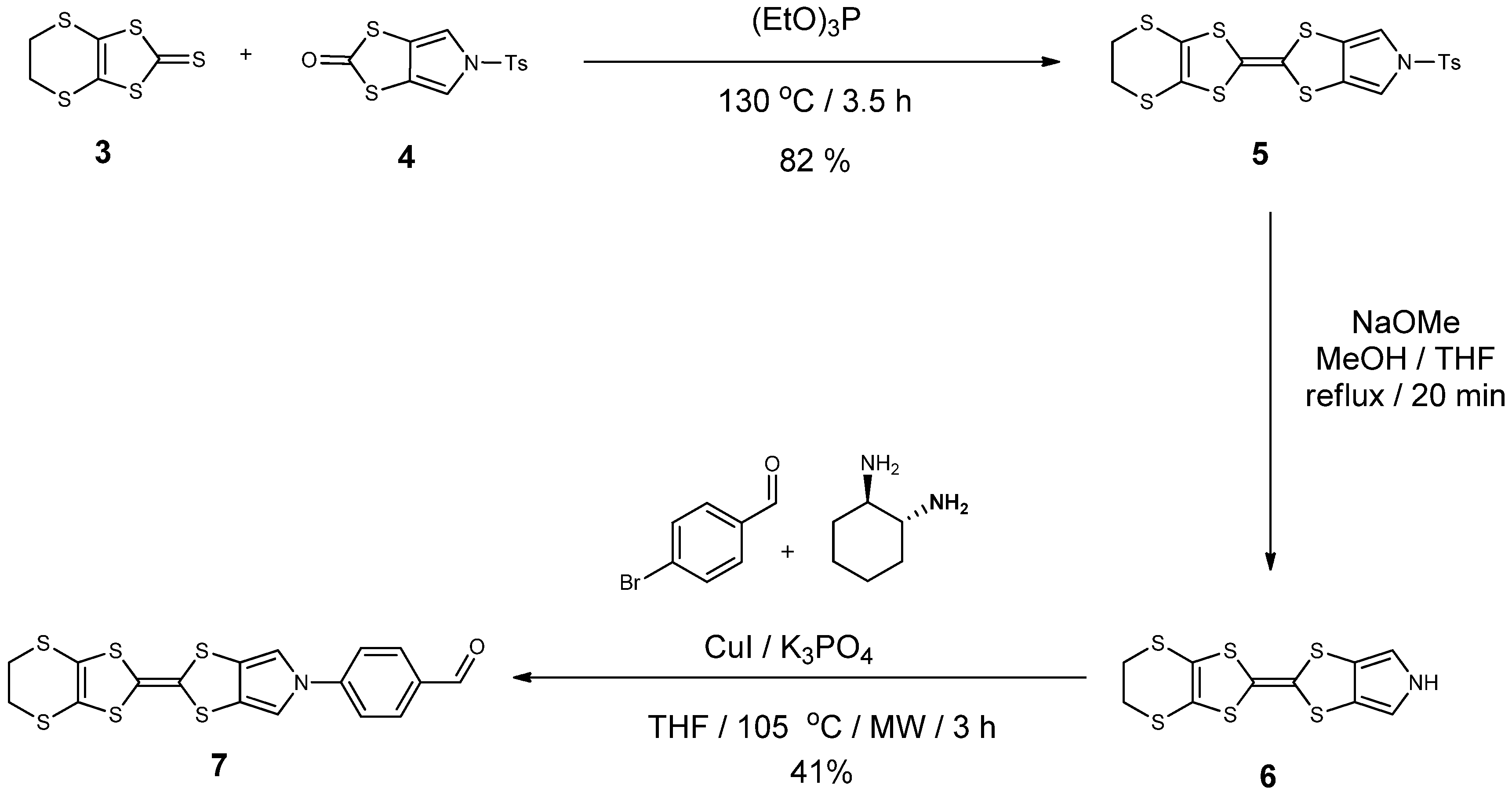
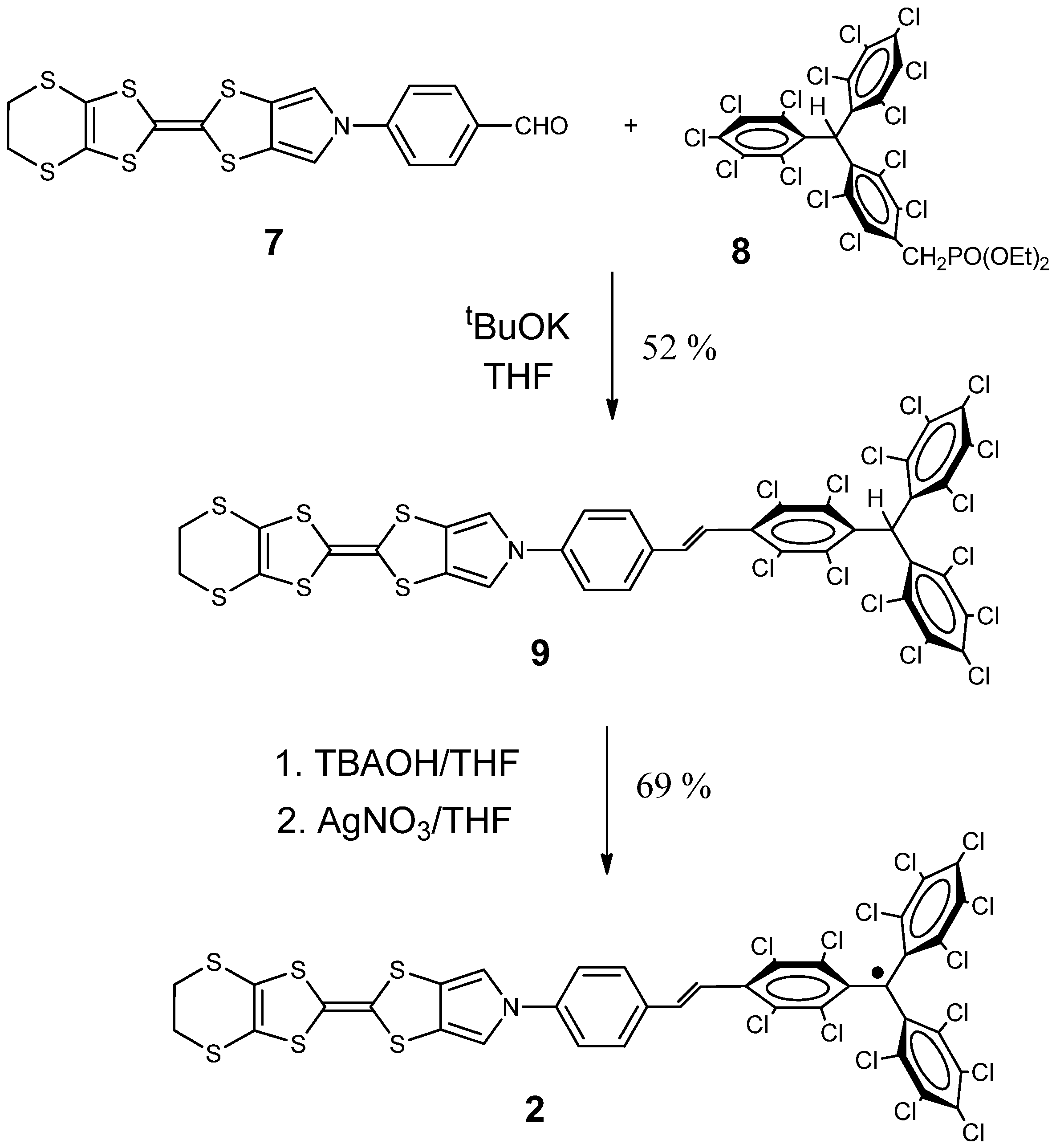

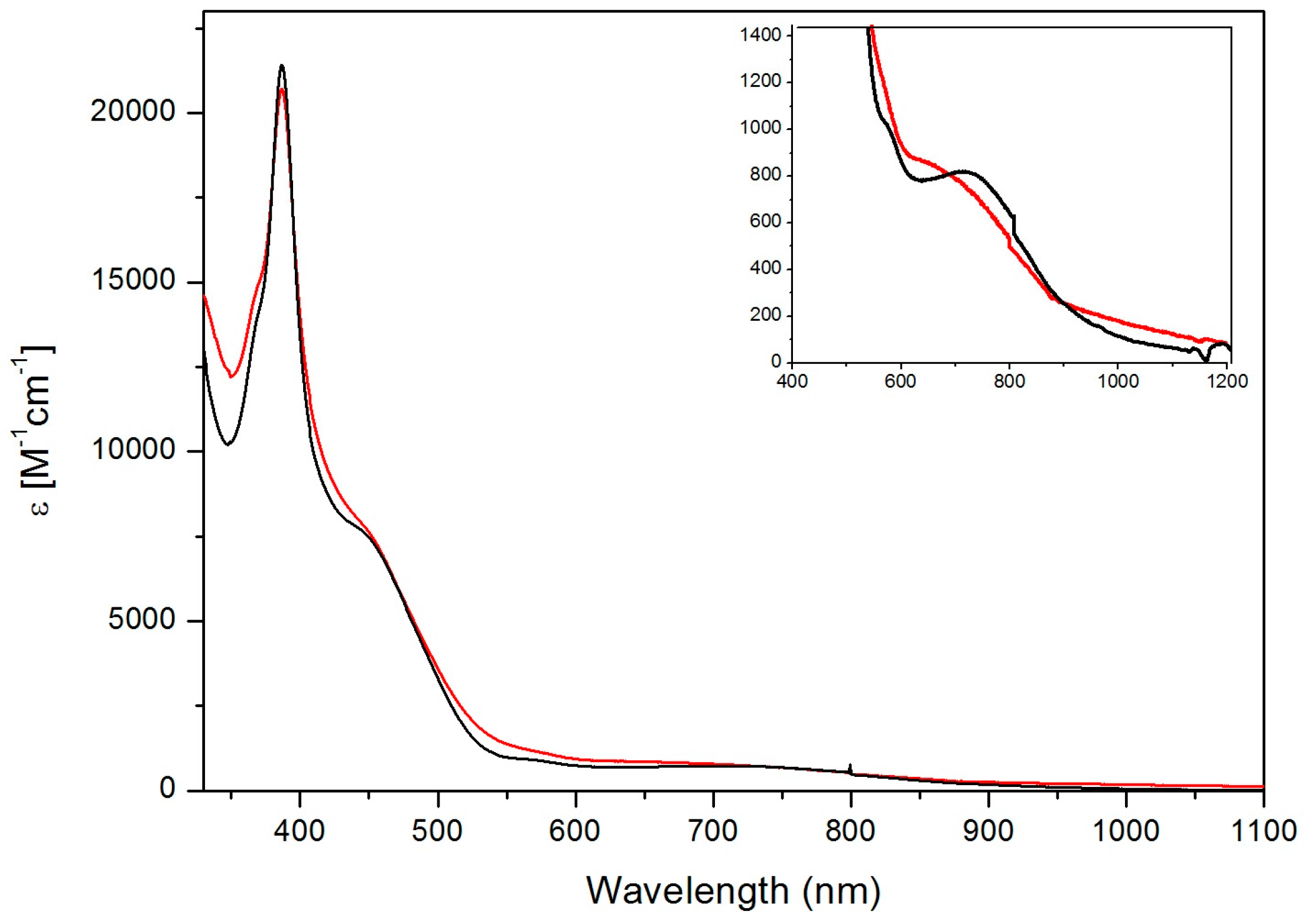

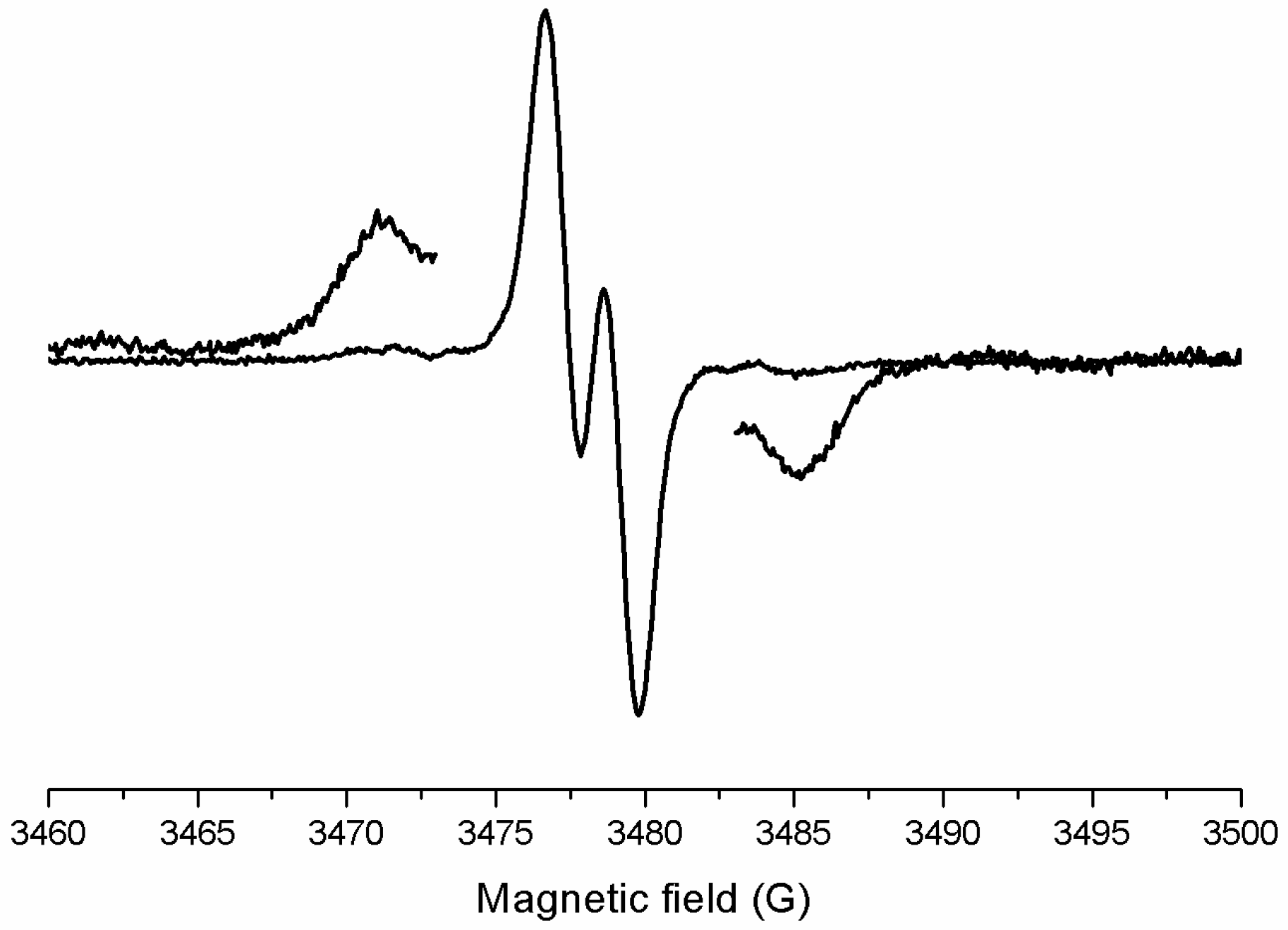
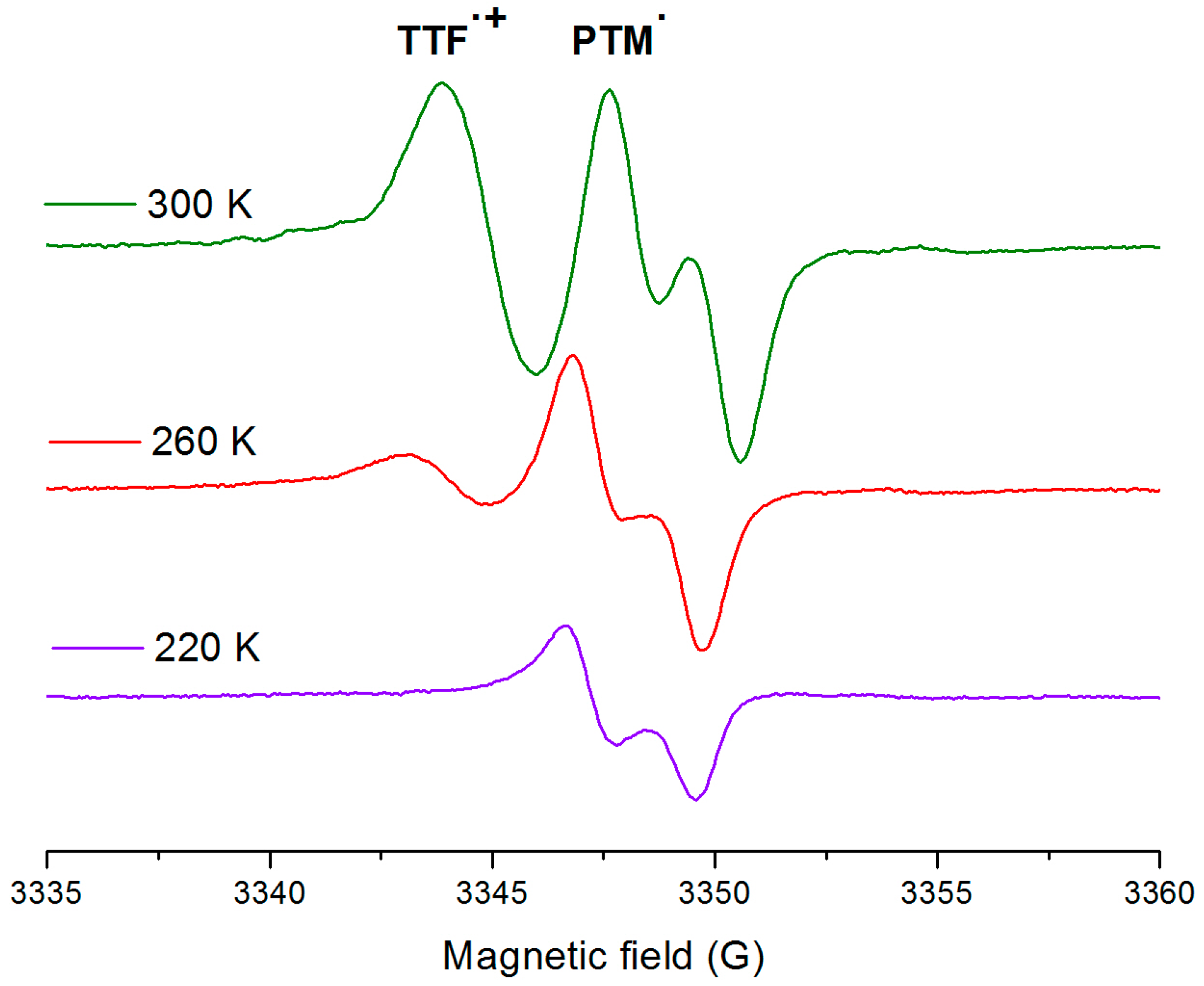
| Dyad | Ered1/2 (V) | Eox11/2 (V) | Eox21/2 (V) | ∆E(1) (V) a | ΔE(2) (V) b |
|---|---|---|---|---|---|
| 1 | −0.19 | +0.45 | +0.95 | +0.64 | +0.50 |
| 2 | −0.22 | +0.51 | +0.95 | +0.73 | +0.44 |
© 2016 by the authors; licensee MDPI, Basel, Switzerland. This article is an open access article distributed under the terms and conditions of the Creative Commons Attribution (CC-BY) license (http://creativecommons.org/licenses/by/4.0/).
Share and Cite
Souto, M.; Bendixen, D.; Jensen, M.; Díez-Cabanes, V.; Cornil, J.; Jeppesen, J.O.; Ratera, I.; Rovira, C.; Veciana, J. Synthesis and Characterization of Ethylenedithio-MPTTF-PTM Radical Dyad as a Potential Neutral Radical Conductor. Magnetochemistry 2016, 2, 46. https://doi.org/10.3390/magnetochemistry2040046
Souto M, Bendixen D, Jensen M, Díez-Cabanes V, Cornil J, Jeppesen JO, Ratera I, Rovira C, Veciana J. Synthesis and Characterization of Ethylenedithio-MPTTF-PTM Radical Dyad as a Potential Neutral Radical Conductor. Magnetochemistry. 2016; 2(4):46. https://doi.org/10.3390/magnetochemistry2040046
Chicago/Turabian StyleSouto, Manuel, Dan Bendixen, Morten Jensen, Valentín Díez-Cabanes, Jérôme Cornil, Jan O. Jeppesen, Imma Ratera, Concepció Rovira, and Jaume Veciana. 2016. "Synthesis and Characterization of Ethylenedithio-MPTTF-PTM Radical Dyad as a Potential Neutral Radical Conductor" Magnetochemistry 2, no. 4: 46. https://doi.org/10.3390/magnetochemistry2040046






